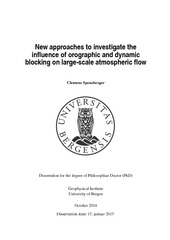New approaches to investigate the influence of orographic and dynamic blocking on large-scale atmospheric flow
Doctoral thesis
Permanent lenke
https://hdl.handle.net/1956/10589Utgivelsesdato
2015-01-15Metadata
Vis full innførselSamlinger
- Geophysical Institute [1198]
Sammendrag
Orographic and dynamic blocks have a profound influence on both weather and climate. The persistence of dynamic blocks can, for example, lead to the build-up of extreme temperature anomalies or droughts. In addition, previous studies linked dynamic blocks to Rossby wave breaking events, which can be associated with extreme precipitation. Dynamic blocks occur preferentially at certain locations, and therefore influence local climate. A important climatic effect of orographic blocks is to act as a temperaturebarriers. For example, the North-Atlantic would be significantly colder during winter if Greenland did not shield the North-Atlantic from the climatological cold pool over the Canadian Arctic. Thus, both types of blocking contribute to the zonal asymmetries in the climate and in the atmospheric circulation. Unfortunately, our understanding of the dynamics of both types of blocking is still far from complete. One of the main challenges in trying to grasp the essentials of blocking is the importance of non-linear effects. These effects are important, because the flow diversion around a block constitutes a large deviation from an unblocked basic state, such that the differences in the advection cannot be neglected. For that reason, previous studies proposed different indicators to capture the transition from linear flow over to non-linear flow around orography. Despite this effort, none of the proposed indicators is generally applicable. Furthermore, it is unclear how dynamic blocks interact with breaking Rossby waves and whether variability indexes like the North-Atlantic Oscillation are resulting from variability of blocking and/or wave breaking. In this thesis, I pursue three novel approaches to enhance the understanding of blocking. First, I demonstrate that deformation is a suitable diagnostic for detecting and quantifying the magnitude of orographic and dynamic blocks. Consequently, deformation helps to investigate the splitting of synoptic systems at the Rocky-Mountain barrier. Furthermore, I show that the deformation associated with Rossby wave breaking is aligned with the observed mean deformation up and downstream of a dynamic block. Thus, the deformation associated with the wave breaking reinforces the flow diversion around the dynamic block, establishing a potential link by which Rossby wave breaking can strengthen a dynamic block. Second, I adapt an existing scheme for upper-tropospheric jet detection. The detected jet axes open up new perspectives on the relation between jets and blocking, because they condense dynamically relevant information about the distribution of horizontal wind shear into a set of jet axis lines. Jet axes also provide the basis to directly analyse variability of the jet location. Usually, this variability is characterised indirectly by geopotential variability. I find the leading variability patterns of the jet location in the Atlantic and the Pacific to be consistent with the variability described by the North- Atlantic Oscillation and the Pacific-North American pattern, respectively. However, in both the Atlantic and the Pacific, the second variability patterns of the jet location has no clear counterpart in the geopotential-based variability patterns. Both the East Atlantic pattern and the West Pacific pattern are related to the two leading variability patterns of the jet location. Third, I devise and implement a new model named “Bergen dynamic model” (BEDYMO), that combines the quasi-geostrophic and dry hydrostatic primitive equations in one model. BEDYMO hence allows to easily switch between the two approximations, facilitating a direct assessment of the effect the processes that are neglected in the transition from the primitive equations to quasi-geostrophy. Therefore, BEDYMO is an ideal tool to assess the importance of these processes for simulating a given aspect of the atmospheric dynamics. Although BEDYMO is designed with an application to blocking in mind, this aspect is not limited to either type of blocking.
Består av
Paper I: A new look at deformation as a diagnostic for large-scale flow. Spensberger, C. and Spengler, T. (2014), Journal of Atmospheric Sciences, 71, 4221–4234. The article is available at: http://hdl.handle.net/1956/10588.Paper II: Paper II: The splitting of synoptic systems at the Rocky Mountains barrier. Egger, J., Spensberger, C. and Spengler, T. (2014), in preparation for Monthly Weather Review. Full text not available in BORA.
Paper III: Upper tropospheric jet axis detection and application to the boreal winter 2013/14. Spensberger, C., Spengler, T., and Li, C. (2014), in preparation for Monthly Weather Review. Full text not available in BORA.
Paper IV: Wintertime variability of mid-latitude jet axes. Spensberger, C., Spengler, T., and Li, C. (2014), in preparation for Journal of Climate. Full text not available in BORA.
Paper V: Bedymo, a combined quasi-geostrophic and primitive equations model. Spensberger, C., Thorsteinsson, T., Spengler, T. (2014), in preparation for Geoscientific Model Development. Full text not available in BORA.
